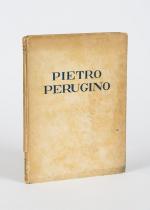[Peruginoi, Pietro Perugino.
Pietro Perugino. No. 254 of a limited edition of 1,000 copies printed.
Spoleto, Claudio Argentieri, Edizioni d’Arte, 1923. 24 cm x 32.2 cm. Portrait frontispiece (with tissue guard), 80 pages. 51 beautiful monochrome images on plates. Hardcover [publisher’s original tanned cloth] with lettering on spine and front board. Discreet price stamp to back board. Spine missing. Bookblock intact. Interior is bright and clean. Inscribed by the author Umberto Gnoli on the titlepage: “A Mrs. Will. Gordon, cordialement, a l’auteur – 1928”.
Pietro Perugino (c.1450 – 1523), born Pietro Vannucci, was an Italian Renaissance painter of the Umbrian school, who developed some of the qualities that found classic expression in the High Renaissance. Raphael was his most famous pupil. Contemporaries regarded Perugino as one of the leading painters in Florence in the 1480s and as the “best master in Italy” in 1500 but soon afterward his reputation suffered a decline from which it has only partly recovered. The grounds for this criticism, then as now, is the formulaic quality of his work, in particular his tendency to repeat figure types or even whole compositions again and again. He was also head of a very large workshop, which, operating for a time in both Florence and Perugia, turned out innumerable devotional pictures and frescoes in his distinctive style. (U.S. National Gallery of Art website)
In 1481 he was summoned to Rome where, along with others, he worked on the frescos for the walls of the Sistine Chapel. His contribution to the Chapel included “The Charge to St Peter”, “Moses leaving to Egypt” and “The Baptism of Christ”.
Among his most important works, which are covered by the book, are: Christ Handing the Keys to Saint Peter (1481-2, Vatican, Sistine Chapel), the tondo of the Virgin with Saints and Angels, Apollo and Marsyas, and St Sebastian (all in the Louvre); The Crucifixion (1493-6, Chapter House of Santa Maria Maddalena del Pazzi, Florence); Pieta (1494-95, Uffizi); Lamentation over the Dead Christ (1495, Pitti Palace, Florence); the Resurrection (Vatican); the Marriage of the Virgin (Caen Museum); the frescoes in the Audience Chamber in the Sala del Cambio, Perugia (1500); and several outstanding portraits – notably those of Francesco delle Opere (1494), Don Biagio Milanesi and Don Baldassare di Antonio di Angelo (all in the Uffizi Gallery, Florence).
Umberto Gnoli (Roma, 21 maggio 1878 – Campello sul Clitunno, 15 gennaio 1947) è stato uno storico dell’arte, funzionario e docente italiano.
Nasce a Roma nel 1878; la madre è Giuseppina Angelini di Perugia, il padre è Domenico, letterato, storico dell’arte, direttore a Roma della Biblioteca nazionale Vittorio Emanuele, della Biblioteca Casanatense e della rivista Archivio storico dell’arte (1888-97). Dal padre eredita l’amore per l’arte e la letteratura, dalla madre l’amore per l’Umbria. Ultimo di otto fratelli, viene precocemente avviato agli studi classici. Studente brillante, frequenta il collegio Rosi di Spello e si laurea nel 1906 a Roma con Adolfo Venturi, collega e amico del padre, discutendo una tesi sull’arte romanica umbra, pubblicata sulla rivista Augusta Perusia fondata e diretta da Ciro Trabalza.
Inizia una collaborazione con Trabalza, dedicandosi soprattutto al reperimento di immagini fotografiche e all’impostazione redazionale della rivista che però, a causa degli alti costi, uscirà per soli tre anni.
Nel 1909 fonda una propria rivista dal titolo Rassegna d’arte umbra; si avvale del contributo di Dante Viviani, in qualità di garante scientifico, e del sostegno di intellettuali stranieri come Bernard Berenson, di politici come Cesare Fani e di molti esponenti della nobiltà perugina come Vittoria Aganoor (che sostiene economicamente la rivista), Rodolfo Pucci Boncambi, Vincenzo Ansidei e la contessa Margherita Hummel. Anche Rassegna d’arte umbra sarà pubblicata per soli tre anni, con un’interruzione di dieci anni fra la prima serie (1909-1911) e la seconda (1921). Nei primi numeri vengono trattate e valorizzate opere di Niccolò di Liberatore, detto l’″Alunno”, Pietro Vannucci, detto il “Perugino”, e Pietro Lorenzetti. Nel frattempo collabora ripetutamente con la rivista ufficiale del Ministero della Pubblica Istruzione, il Bollettino d’Arte. (Wikipedia)
- Keywords: Art · Art of the 15th Century · Art of the 16th Century · Catalogue Four – International Art · Fresco · Illustrated Books · Italian · Italian Art · Italian Painting · Italian portrait paintings · Italian Religious History · Italian Renaissance · Renaissance · Renaissance Art
- Language: Italiano
- Inventory Number: 120294AB
EUR 75,--
© 2025 Inanna Rare Books Ltd. | Powered by HESCOM-Software












